Disclosure: Meeple Mountain received a free copy of this product in exchange for an honest, unbiased review. This review is not intended to be an endorsement.
“Uh oh…is this another one of these games where it is all about tracks?”
It was game night at the Bell household, and my wife joined me for my fourth (of five) plays of Endeavor: Deep Sea (2024, Burnt Island Games). I had figured out a way to trick her into joining me with one of her favorite words: co-op.
“OK, OK, that’s fair,” I replied. “But, we are playing together! This game supports co-op scenario play!”
“We will be playing together? OK, fine. As long as this is easy to teach, let’s do it.”
We did play on the same team, and save for a few complaints, my wife enjoyed that cooperative session. Despite the fact that Endeavor: Deep Sea is a game that has the look of medium-to-heavy strategy game tracks, the interesting puzzle and exceptional production make it a breezy time at the table.
Well…at least the second half of each game was good.
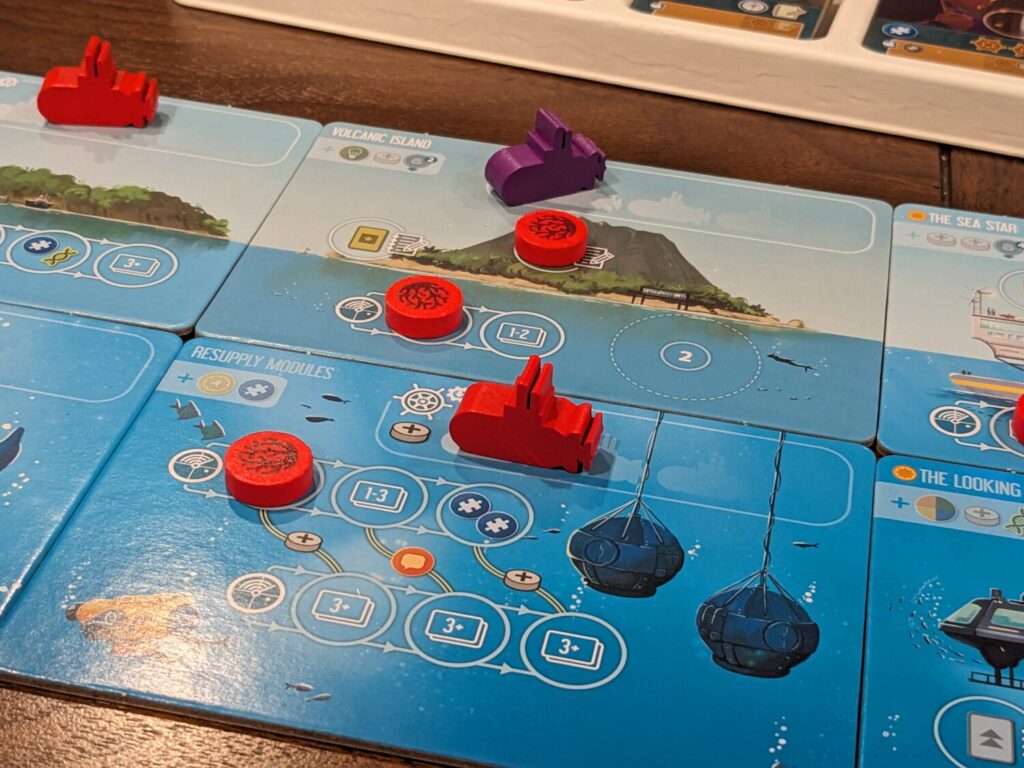
See You, SETI Me
Endeavor: Deep Sea is a 1-4 player exploration game that allows a player to attack its core puzzle solo, as a cooperative experience, or as a competitive game. Across my five plays, I tried all three formats and found that the game’s 10 included scenarios offered a rich variability for players who want to go hard on the Endeavor system. (I have not played the original Endeavor nor Endeavor: Age of Sail, but I am told that Endeavor: Deep Sea is a somewhat lighter version of those previous games.)
Over the course of six or seven rounds (based on player count), the aim is to achieve a number of goals as a team or score the most points in competitive mode. Rounds always play out the same way, with players doing three simple administration steps before taking a single action by activating one of a growing roster of crew members to traverse or discover new parts of the modular board, dive to research the ocean, or take journal actions to spend that research on bonuses and track bumps.
The best thing about Endeavor: Deep Sea is accessibility. I taught this game to my wife in about 10 minutes. Set up is incredibly simple, thanks to very clear instructions provided on each of the game’s 10 mission sheets. The rulebook is so good that I didn’t initially watch a teach video to learn the rules, and the examples, bolding, and sidebar boxes in each rules section made it very clear what each icon stood for, what the limited edge cases meant, and how each crew member action could be activated and resolved.
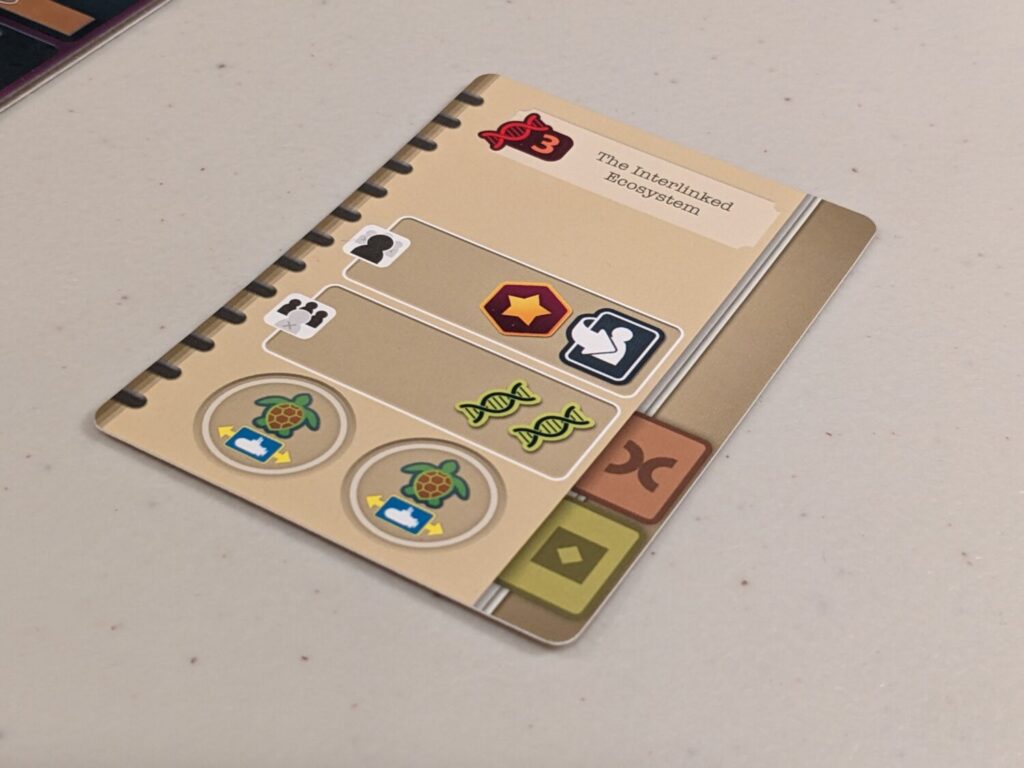
Once a player has the pool of maybe 20 icons down, Endeavor: Deep Sea is a family-weight game. (No, there is no player aid. Yes, the game badly needs one. No, publishers have not been taking my advice.) Younger children might not understand the strategic elements of longer-term planning–particularly with the steps surrounding the three goals available for each mission, which end up being a critical part of scoring—but my kids would absolutely understand the core mechanics here, that pushing up each of the four main tracks is vital to doing everything a player wants to do later.
The four tracks are tied to accessing better crew members during the administration stage, gaining more action points (represented here in the form of small discs placed on crew members or map tiles), retrieving discs from previously-activated crew, and ship range. The addition and retrieval of discs felt more important than the other two tracks, but I found that neglecting even one track for an entire game led to major issues by the time end-game scoring arrived.
Building out the map is fun, and 37 map tiles are included in the box. During setup, 3-5 tiles are laid out in a grid, then players slowly build out the map using the Sonar action. Many of the tiles have special rules that shake up play, so it was always cool to see how the tiles would change the approach in a given game. Some have special powers, some allow players to move after taking actions, all have an arrival bonus that factor into travel planning, and one posed a fun problem each time it appeared: players can’t travel through that tile but can access it via caves that connect to adjacent tiles.
This is all to say that Endeavor: Deep Sea has a lot going for it. So why did I like it more than I loved it? Because Endeavor: Deep Sea has what I like to call “the SETI problem.” Endeavor: Deep Sea feels way too short because it takes too long to get to the heart of what makes it shine.
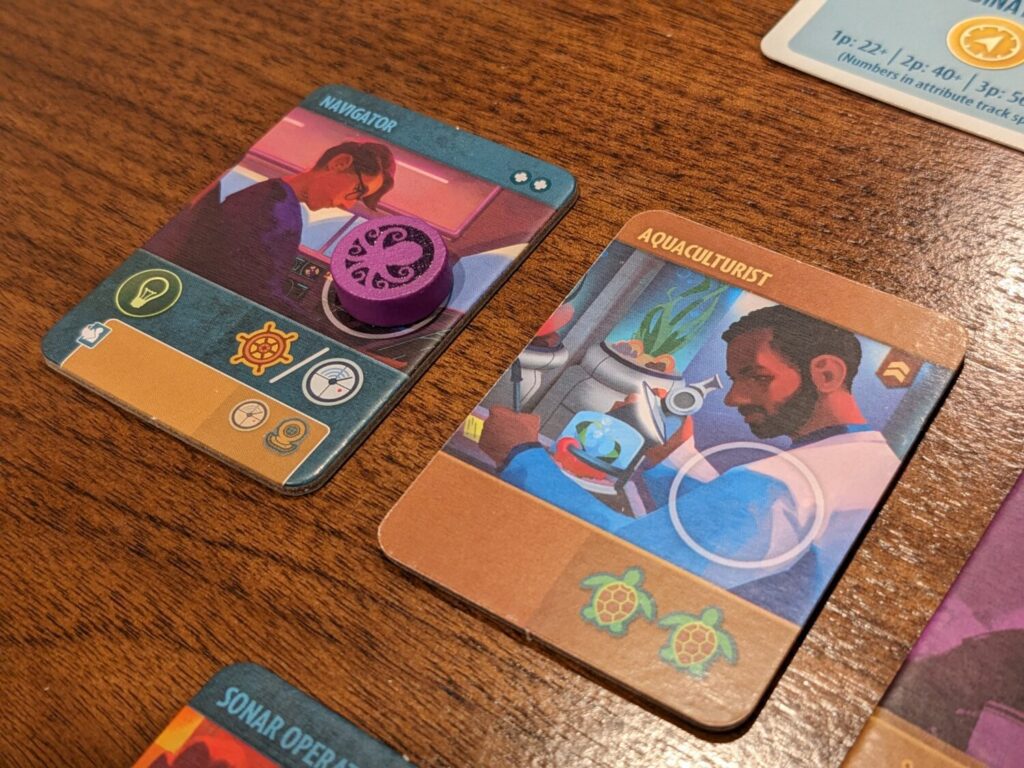
“Wait, This is the Last Round?”
During the first round of each play of Endeavor: Deep Sea—even during my fifth and final review play—I only took two actions before the round was over.
I would activate my “Team Leader” to take an action—every player has one starting crew member, the Team Leader, who can do all of the game’s five main actions—then I would take an action with a level one crew member. Sometimes, I had three action points to take those two actions, sometimes just two action points. In the latter case, that sometimes meant I took a Journal action, which means I had to place an action disc on the Team Leader, then an action disc on the Journal action space of the tile on the main board.
And that was the end of round one.
Usually, round two played out the same way. In one game, I took two actions for each of the game’s first three rounds, as each action cost me two discs in that particular game.
This meant that in a couple of cases, a game of Endeavor: Deep Sea featured three of its six rounds where all I did was basically set up for the back half of the game.
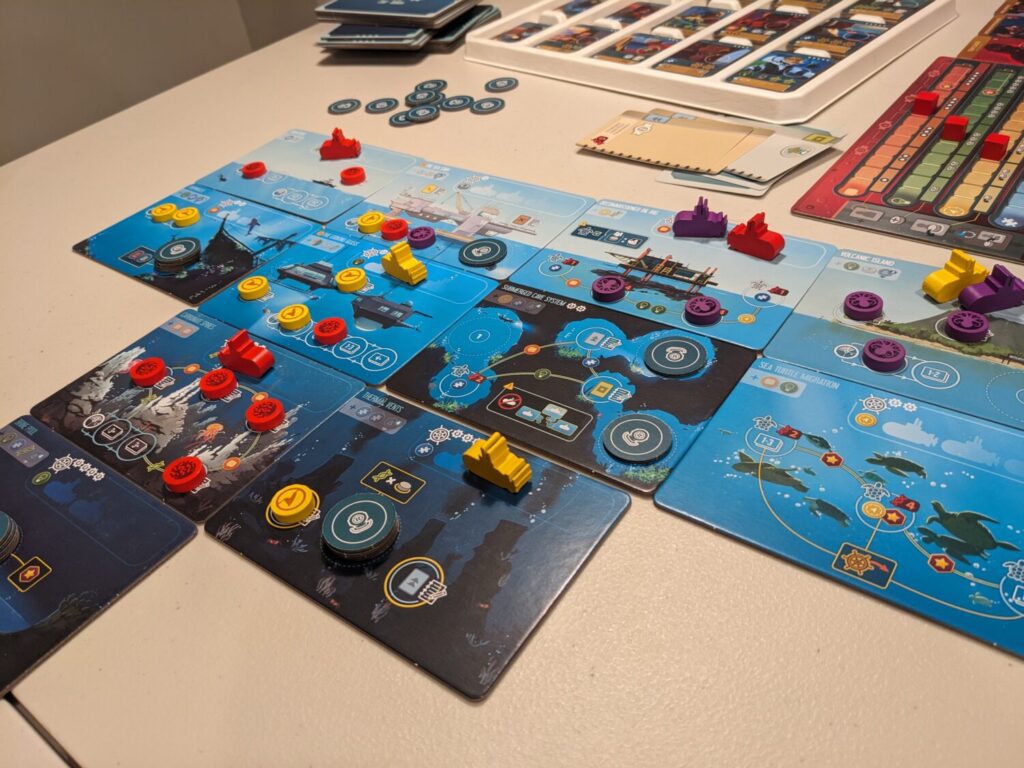
Have you played SETI: Search for Extraterrestrial Intelligence? I love SETI, but a fair criticism of the design comes whenever players spend the first round taking one, maybe two actions, then passing. (I’ve seen this with new players in almost every playthrough.) SETI really feels like a game that should have four rounds instead of five, with players getting more stuff during setup instead of playing a round where you can do almost nothing meaningful.
Endeavor: Deep Sea gives me similar vibes. The design here feels like it needs fewer rounds and more resources available during setup. As it is, the first few rounds of the game never got my juices flowing in the way rounds four, five and six did. By then, the “Impact Board” that shows the mission, its goals, and spaces for achievement tokens had a lot more action. Players were taking more time to study the game state and make interesting decisions. Endeavor: Deep Sea has almost no real interaction—maybe the Journal card market, where players might snipe a card you were hoping to grab?—but what interaction it does have only really picks up late in the game.
So, that was my main concern here…it just feels like players will go through the motions early on. My other main issue is the tracks. I never had a problem pushing up the four main tracks. Between the recruiting action, the Impact board, the Sonar action, and the Travel action, there are so many easy ways to push up tracks that I wished that mechanic was a bit more challenging. In competitive mode, there is a points bonus attached to reach different track thresholds, and we found that players were always able to easily score 34-40 points for track thresholds. (This is the bulk of the scoring in Endeavor: Deep Sea, in games where players usually end up in the 60-75 point range.)
This is not to imply that Endeavor: Deep Sea is not challenging; quite the contrary, particularly during co-op and solo play, where event cards change the game’s rules and players have to meet certain requirements that felt pretty tough even in the first two missions. (I tried the game’s first five missions, out of the ten in the box.)
My issue is that the game already feels “samey” in terms of what’s important. You must push up the green and yellow tracks to get more action points and pull more discs back from crew members. You have to aim for at least second place on each of a mission’s three goals. All crew members have their uses, but certain crew members (and specifically your Team Leader) seem to get the love each and every round.
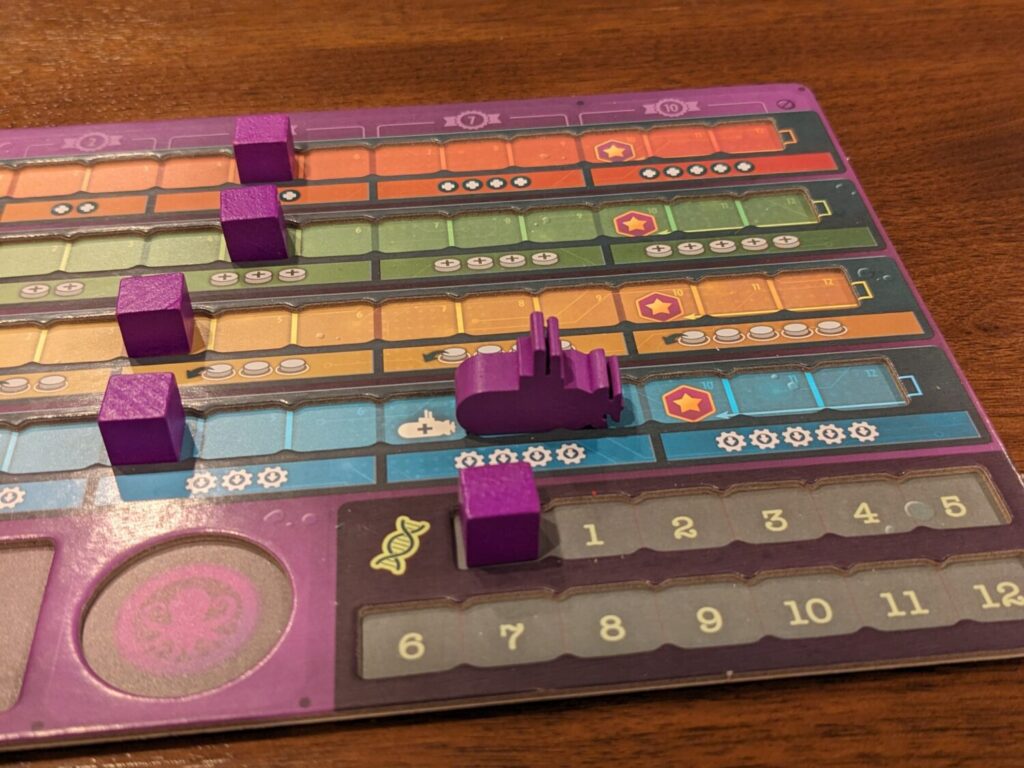
Broad as the Sea is Deep
Endeavor: Deep Sea was fun, but ultimately I am struggling to see what others have experienced in their appreciation for the design. (The game currently resides in the BGG list of the top 250 games rated by users, so it is possible that this struggle is my own.) I appreciated the map variability, the passive bonuses awarded to opponents who didn’t take part in some of the Journal card actions, the included recruit storage tray, and a game that onboards new players so easily.
For those reasons, I will hold onto the review copy of Endeavor: Deep Sea…for now. That’s because I’m excited to play this more with my family, who won’t worry as much about some of the warts I described earlier and because my kids don’t mind some of the minutiae tied to the early rounds. And I think a lot of people might enjoy a game where there’s not much happening early before the action crescendos at the halfway mark into something much more interesting.
As a lover of games with tracks, there are so many Euros that outshine what I see in Endeavor: Deep Sea. Even other track-rich games I’ve reviewed over the last few months—such as Minos: Dawn of the Bronze Age, Transgalactica, Men-Nefer, and Daitoshi—had more interesting bonuses or a bit more tension in attaining different levels of achievement. I liked the recruit step of each round, even if I found myself aiming for the same few recruits in each game.
I enjoyed Endeavor: Deep Sea, but I’m not experiencing the kind of pull other games have over me when I am grabbing titles to throw in the bag for game night. It was fun, but it was never “wow”, if that makes sense. I am intrigued to go back in time to try the other Endeavor games to see how they land for me.


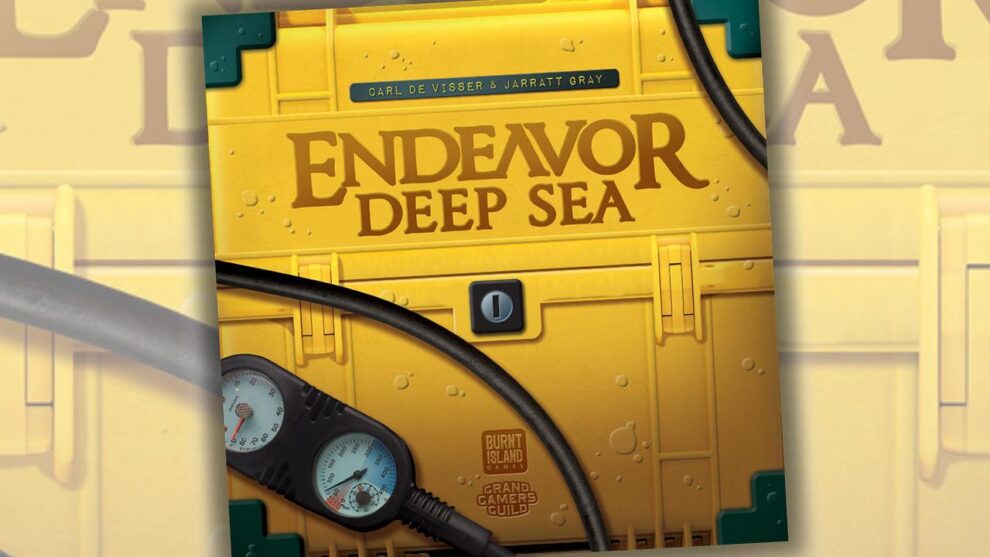



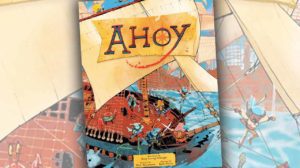



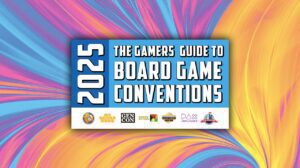

Disappointing fo read this when my copy arrived the same day your review came out. I would advise against the first two Endeavors which were very ordinary and had questionable theming. I think Dice Tower and Rahdo sold me on Deep Sea so I’m giving it a shot. Appreciate your review!